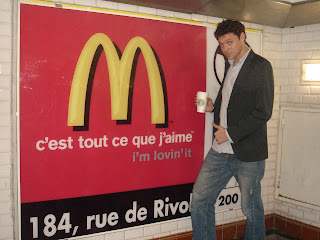I majored in Advertising and Political Science, here is what I learned in school: Once a campaign is developed convention dictates that it be integrated, applied over every media like spreading frosting on a cake. Design a good media mix, get a little multiplier effect going on and then call it a day!
The idea being, if a brand is the same everywhere, all the time, broadcasting a message that is disruptive and persuasive, its image burns into the audience’s mind like the memory of a first kiss or that time you hurled after accidentally drinking sour milk.
It is painfully obvious however that some brands are currently writing a new playbook, and with great success. I term them 21st century brands, but I suppose you could just call them smart. Yet, with home internet access almost 20 years old, only recently has it become apparent to even these innovators that there is real value in changing things up. Look back at say, the results of online fundraising for the past three presidential elections and woah, where did 2008 come from?! Sure, the internet and mobile technology evolved a great deal in a short time, so perhaps we owe it to that? Yeah ok, maybe. But it’s not as if Facebook is worlds apart from Friendster, a permutation with better marketing at best. Far more significant I’d argue has been the sharp increase of the general public’s literacy with these mediums, that they in depth and breadth have finally grown enough to change the game.
In terms of shifting paradigms, politics are decent gauge. Richard Nixon got spanked by JFK in 1960 because by then more people were watching TV than listening to radio; and Nixon refused to tan like a girl or wear makeup. Turns out sweaty and pale doesn’t come off as presidential. But eight years later Nixon was back, and with a presidential bid hailed by many as the first “modern political campaign” – winning him the White House and two mentions in Billy Joel’s hit song, “We Didn’t Start the Fire.” Not bad.
The 1960 presidential election demonstrated the power of television just over twenty years after becoming commercially available. There is no doubt that 2008 was another game changing year. We had a new media environment, fueled by a more mature ‘web 2.0’ and sophisticated mobile technology that, most importantly, for the first time ever was actually being used by a majority of people. In other words, internet literacy had finally caught up with the technology available.
There’s no need to rehash how the Obama campaign was able to translate clicks and texts into real world actions or word of mouth buzz into persuasion by facilitating two way communication and foster community around shared meaning. Or to point out again how the supporters themselves became an integral part of the campaign/ brand structure, committing their time, money and passion to movement, and actively helping to write its story.
It is important to note, however, that for all the campaign's media savvy, none of this would have been possible without an electorate actually using and fluent in the capabilities of online and mobile technology. Or rather, using it and using it well.
What Obama did may or may not have specific lessons for brands. Let’s be honest, DEWmocracy wasn’t really that cool or successful - it was actually pretty lame. However, with a step back, one solid fact we can take away from the political sphere in 2008 is that similar to 1960, twenty or so years after its debut the net unarguably came into its own. How we interact with media has finally changed to the extent that ignoring it is simply not an option. We certainly won’t see any serious political candidate ignore this fact in the future and any truly successful 21st century brands will be the ones placing a high premium on adapting to this new space.
Marshall McLuhan coined, “the medium is the message” in 1964 and four years later Nixon demonstrated better than anyone that he got the message. Tick tock.
The Siksika Hierarchy of Needs
2 hours ago






0 comments:
Post a Comment